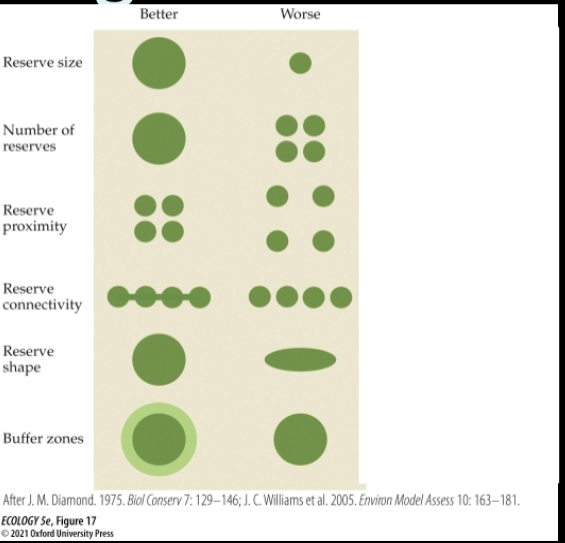Landscape Ecology Flashcards
1/27
Earn XP
Description and Tags
Flashcards about Landscape Ecology
Name | Mastery | Learn | Test | Matching | Spaced |
|---|
No study sessions yet.
28 Terms
Landscape Ecology
Examines spatial patterns and their relationship to ecological processes.
how landscape elements can influence an area
Bowman et al., 2018
Habitat Loss and Fragmentation
Decrease habitat area, isolate populations, and alter conditions at habitat edges.
Bownman et al., 2018
Biodiversity Sustainability
Best sustained by large reserves connected across the landscape and buffered from areas of intense human use.
Bownman et al., 2018
Landscape Ecology Origin
Evolved from a fusion of theoretical backgrounds in geography, ecology, planning, and landscape architecture, originating in central Europe.
Turner, 2005
Contemporary Landscape Ecology
An interdisciplinary systems science which aims to integrate ecological, geophysical, social, and analytical approaches.
focus on natural processes
incorporated into planning - conservation
Turner, 2005
Landscape Ecology Term Introduction
Introduced by German biogeographer, Carl Troll (1939).
fairly new
Landscape
Area in which at least one element is spatially heterogeneous; often includes multiple ecosystems.
Bowman et al., 2018
Landscape Patterns
Spatial configuration (arrangement) of habitats and the habitat composition.
what types of habitat are present ?
in what abundance is each habitat type ?
Turner et al., 2001
Remote Sensing Satellites - Landscape Ecology tools
Provide images of Earth that expand our view of large-scale ecological patterns.
Bownman et al., 2018
Geographic Information Systems (GIS) - Landscape Ecology tools
Computer-based systems used in landscape planning, conservation, and urban development for storage, analysis, and display of spatial data.
Bownman et al., 2018
Global Positioning Systems (GPS) - Landscape Ecology tools
Allow ecologists in the field to document precise locations of species and other variables.
Bowman et al., 2018
Radiotelemetry
Allows tracking of animal movements and migration patterns.
Bowman et al., 2018
Connectivity
Spatial continuity of a habitat type across the landscape.
Weins, 2007
Landscape Composition
Number of elements or patches and how much of each element is present.
Weins, 2007
Movements across Heterogenous Landscape
may include many ecosystems that are dynamic and interact with eachother
interactions occur through - water, energy, nutrients
biotic movement across corridors
Weins, 2007
Habitat Connectivity
The degree to which the landscape facilitates or impedes movement amongst different resource patches.
High = close proximity
Low = habitat patches being isolated
Weins, 2007
Connectivity influences …
Species composition and interactions
productivity
nutrient cycling
ecosystem resilience
Weins, 2007
Structural Connectivity
Continuity among habitat patches.
Weins, 2007
Functional Connectivity
Actual habitat use by organisms; species-specific.
Weins, 2007
Habitat Corridors
Linear patches that connect blocks of habitat.
Weins, 2007
Influence of surrounding landscape
landscape structure - plays a role in ecological dynamics
landscape structure - influences biogeochemical cycling
Weins, 2007
Disturbance shares landscape patterns
human change nature + disturb it
E.g. Yellowstone National Park 1988 fires burned 1/3 of area leading to complex mosaic of patches
Habitat Loss and Fragmentation
Human activities - urbanisation, roads etc
reduction in habitat available for other species
many species go extinct
Bownman et al., 2018
Habitat loss and fragmentation - Case study
Lago Guri, Venezuela
formation of islands in matrix of water
opportunity to study fragmentation
Bownman et al., 2018
Habitat loss creates edge effects
deforestation creates new edges - exposing trees once surrounded by forest edge
can have different abiotic and biotic system
Bownman et al., 2018
Connectivity and protected area design
Terrestrial Example: Trumpeter hornbills in KwaZulu– Natal, South Africa
Steep slopes, gorges, & subtropical forests
Oribi Gorge Nature Reserve
Mbumbasi Nature Reserve KwaZulu-Natal
Fragmentation
Sugarcane plantations
Rural areas & roads
Farm gardens
Indigenous fruit-bearing trees rely on frugivorous birds for seed transport
Bownman et al., 2018
Designing nature reserves
certain designs better than others
connectivity important t- but if too close - increases risk of disease spread

Marine Example: Reef fishes in Moreton Bay Marine Park, Australia
Network of no-take reserves
○ Coral reef, mangrove, seagrass Moreton Bay - heterogenous
● Reserves revised in 2008
● Guiding questions:
○ Are key seascape connections being protected?
○ Could the reserve network be updated to improve conservation outcomes?
Bownman et al., 2018